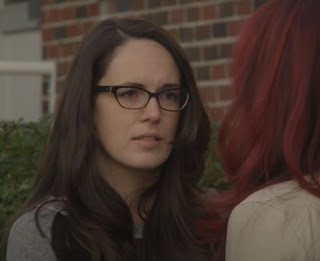Text © Richard
Gary / Indie Horror Films, 2020
Images from
the Internet
Blood Pi (aka Blood π)
Directed by Jordan
Pacheco
Lock It Down
Productions
91 minutes, 2020
https://www.facebook.com/BLOOD-Pi-1475601389429732
College is a time for growth, for learning, and apparently for dying by a horrible method, if you follow the trend of a multitude of slasher films. For this dramedy, we are welcomed to River Falls University (RFU), which I am assuming is in New England, where this was shot… er… filmed.
RFU is also a school that likes its winning football
team and especially its wild parties, where the overaged female students are
all beautiful and the males are the beef. But I’m getting ahead of myself here.
There is no surprise about who is the killer as we see the striking -yet-warped
coed Amber (Anna Rizzo) take umbrage with her family in the prologue, which also
gives a hint of sharp (pun intended) and gory humor in the first couple of
minutes.
 |
| Anna Rizzo |
Of course, Amber is a completely murderous sociopath who is obsessed with Agnis, so you know the friendship between the two at some point is going to turn on its head.
But I’m getting ahead of myself. Of course, Agnis and Amber have a blow-out, leading to two altering actions: Amber goes further off the rail (man, Rizzo is good at playing “psycho” with both simmer, eyebrows and rage), and Agnis joins in with the same sorority mean girls who rename her Angie. It’s interesting that the psycho tells her to “change your hair, change your make-up, but be yourself,” and the hot shots want her to change to suit them. As nuts as Amber truly is, she’s actually the better friend than the sorority sisters. There’s an academic paper in there somewhere.
As for the Halloween party which starts Act 2, well, what better way to put some bodies on display (and there is a lot of that in this film), and in harms way of a psycho killer, qu’est-ce que c’est? Agnis, now dubbed Angie by the cool contingent, arrives at the party, as does Amber (Rizzo sure can rock a corset, as she showed previously in A Midsummer Night’s Dream, in 2017). Angie hooks up with a Kavanaugh-ishly rapacious frat boy, Keith (Jamie Dufault, who ironically starred in a film called Murder University in 2012) which does not go well for both parties.
 |
| Sarah Nicklin |
Then there’s the – I kid you not – third shindig, starting the final act, where things really begin rockin’ and people start droppin’. And let the games – and the flowing of blood – begin! Damn, I’m giddy as a sbool boy (Monty Python reference, sorry). Amber learns of the Pi gals’ nefarious plans at Angie’s “pledging” to the sorority where the shit hits the fan and the body count significantly rises. There is one particular kill that is bound to make people squirm (did me), again in a Terrifier motif, but the previous party’s kill kind of balances it out, I guess.
The film touches a bit on some previous work, such as the obsession of Single White Female (1992) among many, and Mean Girls (2004). What’s nice is that this is a pretty meat and potatoes kind of picture, without trying to be too arty, and just give us what we genuinely want to see. There is also a strong influence of a plethora of 1980s releases where a ball becomes an abattoir.
A question I have, as there is no back stories on any
of the characters, as is the nature of these kinds of genre blood-lettings, is that
I wonder whether Amber was always a bad seed and had killed before, or was there
a trigger that set her off on the path of rack and ruin. The other thing about
these kinds of genre blood-lettings is that sometimes the backstories are irrelevant
to the fun that’s on the screen at the moment, and we have a heap of that here.
 |
| Jamie Dufault |
The film definitely pushes some envelopes, which can
be seen as good or bad, but either way it’s bound to shock some and have others
hiding their eyes behind their hands. Of course, true deep genre fans are bound
to be drinkin’ and a hootin’.














